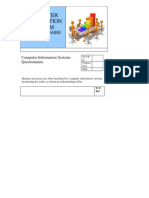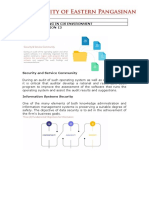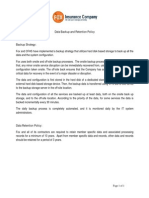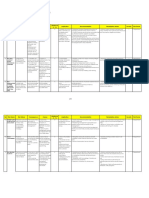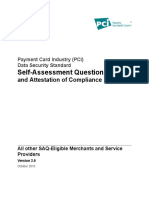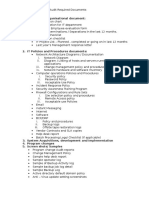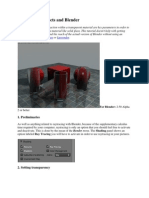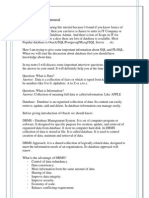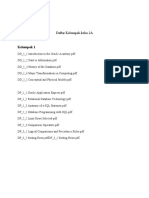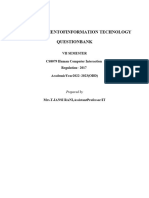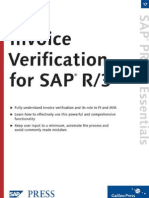100%(1)100% found this document useful (1 vote)
203 viewsIT Security Management - IsMS
IT Security Management - IsMS
Uploaded by
Ravi RamanThere are key steps that every company implementing an Information Security Management System (ISMS) needs to consider, including purchasing the relevant standard, considering training, assembling an implementation team to agree on a strategy, undertaking a risk assessment, developing supporting documentation like a security policy and procedures, choosing a registrar for certification, implementing the ISMS, and undergoing continual assessment to maintain certification. The document outlines the Plan-Do-Check-Act (PDCA) process model that is the basis for ISMS implementation according to the BS 7799-2:2002 standard.
Copyright:
© All Rights Reserved
Available Formats
Download as PPT, PDF, TXT or read online from Scribd
IT Security Management - IsMS
IT Security Management - IsMS
Uploaded by
Ravi Raman100%(1)100% found this document useful (1 vote)
203 views53 pagesThere are key steps that every company implementing an Information Security Management System (ISMS) needs to consider, including purchasing the relevant standard, considering training, assembling an implementation team to agree on a strategy, undertaking a risk assessment, developing supporting documentation like a security policy and procedures, choosing a registrar for certification, implementing the ISMS, and undergoing continual assessment to maintain certification. The document outlines the Plan-Do-Check-Act (PDCA) process model that is the basis for ISMS implementation according to the BS 7799-2:2002 standard.
Copyright
© © All Rights Reserved
Available Formats
PPT, PDF, TXT or read online from Scribd
Share this document
Did you find this document useful?
Is this content inappropriate?
There are key steps that every company implementing an Information Security Management System (ISMS) needs to consider, including purchasing the relevant standard, considering training, assembling an implementation team to agree on a strategy, undertaking a risk assessment, developing supporting documentation like a security policy and procedures, choosing a registrar for certification, implementing the ISMS, and undergoing continual assessment to maintain certification. The document outlines the Plan-Do-Check-Act (PDCA) process model that is the basis for ISMS implementation according to the BS 7799-2:2002 standard.
Copyright:
© All Rights Reserved
Available Formats
Download as PPT, PDF, TXT or read online from Scribd
Download as ppt, pdf, or txt
100%(1)100% found this document useful (1 vote)
203 views53 pagesIT Security Management - IsMS
IT Security Management - IsMS
Uploaded by
Ravi RamanThere are key steps that every company implementing an Information Security Management System (ISMS) needs to consider, including purchasing the relevant standard, considering training, assembling an implementation team to agree on a strategy, undertaking a risk assessment, developing supporting documentation like a security policy and procedures, choosing a registrar for certification, implementing the ISMS, and undergoing continual assessment to maintain certification. The document outlines the Plan-Do-Check-Act (PDCA) process model that is the basis for ISMS implementation according to the BS 7799-2:2002 standard.
Copyright:
© All Rights Reserved
Available Formats
Download as PPT, PDF, TXT or read online from Scribd
Download as ppt, pdf, or txt
You are on page 1of 53
At a glance
Powered by AI
The key takeaways are that IT security management should support business needs and priorities, and that management should be in control of security policies and risk assessments.
The main components of an ISMS are management goal setting based on risk prioritization, establishing structured security elements and methods, and enabling internal and external evaluations for continuous improvement.
Some of the benefits of implementing an ISMS include improved understanding of business aspects, reductions in security breaches and claims, reductions in adverse publicity, and improved structure for continuous improvement.
IT Security MUST
Support to The Business
IT Security people MUST understand The Business and
The Business need to be able to manage IT Security
IT Security Management
Final decisions about IT Security must be taken by The Business Expert
(The Management)
The Management only must decide The level of IT Security in the
company in relation to:
Values (assets)
Image
Business Risks
Requirements from Customers, Partnerships and Company
Business management must
Control the entire cycle of IT Securiy activities
Maintain and follow-up regularly
Reports
A three pronged ISMS approach
Sets framework for:
Management goal setting
based on prioritised risk
Setting up a structured
system with essential
elements and methods
Enables internal and
external evaluation for
further system
development
(improvement)
ISMS
Who needs ISMS?
Every organisation, company, firm institution
handling information: BASICALLY EVERYBODY!
Banks
IT companies
Government (example: tax office)
Consultancy Firms
Hospitals
Schools and Universities
Insurance Companies
Certificate Service Providers, CSPs
just to name a few!
Risk assessment
The bases for ISMS
Inger Nordin
Risk assessment
The basis for ISMS
Per Rhein Hansen
Implementing an Information Security Management System
There are key steps that every company implementing an Information Security Management System will need to consider:
Purchase the Standard
Before you can begin preparing for your application, you will require a copy of the standard. You should read this and make
yourself familiar with it.
Consider Training
There are training courses available to help you implement and assess your Information Security Management System.
Assemble a team and agree your strategy
You should begin the entire implementation process by preparing your organizational strategy with top management. At this stage you should determine the Scope of your
Registration - whether the system will be adopted company wide or by one or more departments.
Review Consultancy Options
You can receive advice from independent consultants on how best to implement your information security management system.
Undertake a Risk Assessment
During this phase you should undertake a review of all potential security breaches. This should not relate solely to IT systems, but should encompass all sensitive information
within your organization.
Develop a Policy Document
This will demonstrate management support and commitment to the Information Security Management System process.
Develop Supporting Literature
Put together a Statement of Applicability and Procedures to support your security policy. This will cover a range of areas including asset clarification and control, personal
security, physical and environmental security and business continuity management.
Choose a registrar
The registrar is the 3rd party, like BSI, who come and assess the effectiveness of your information security management system, and issue a certificate if it meets the
requirements of the standard. Choosing a registrar can be a complex issue as there are so many operating in the market. Factors to consider include industry experience,
geographic coverage, price and service level offered. The key is to find the registrar who can best meet your requirements. A great place to start is by contacting us.
Implement your Information Security Management System
The key to implementation is communication and training. During the implementation phase everyone begins operating to the procedures of the management system.
Gain registration You should arrange your initial assessment with your registrar. At this point the registrar will review your Information Security Management System and
determine whether you should be recommended for registration.
Continual assessment
Once you have received registration and been awarded your certificate, you can begin to advertise your success and promote your business. Your ISMS will be periodically
checked by your registrar to ensure that it continues to meet the requirements of the standard.
http://emea.bsi-global.com/InformationSecurity/ImplementingISMS/index.xalter
Comparison SHALL and SHOULD standards
BS 7799-2:2002 -- SHALL
1 Scope
2 Normative references
3 Terms and definitions
4 Information security
management system
5 Management responsibility
6 Management review of the ISMS
7 ISMS improvement
Annex A (normative) Control
objectives and controls
- table mapping ISO/IEC 17799
Annex B (informative) Guidance on
use of the standard
Annex C (informative) Comparison
between ISO 9001:2000, ISO
14001:1996 and BS 7799-2:2002
Annex D (informative) Changes to
internal numbering
ISO/IEC 17799:2000 -- SHOULD
1 Scope
2 Terms and definitions
3 Security policy
4 Organizational security
5 Asset classification and control
6 Personnel security
7 Physical and environmental
security
8 Communications and operations
management
9 Access control
10 Systems development and
maintenance
11 Business continuity management
12 Compliance
Changes from BS 7799, part 2:1999 to BS 7799-2:2002
Adopted to ISO 9001 and ISO 14001
Better description of management system
Focus on Plan, Do, Check and Act - process
Focus on risk assessment, risk handling, ...
Corresponding tables
BS 7799, part 2, ISO 9001:2000 och ISO 14001
BS 7799, part 2:1999 and BS 7799, part 2:2002
BS 7799-2 and ISO/IEC 17799 should be viewed
as an entity
Requirements in part 2 including description of
the ISMS and Annex A with all the ISO/IEC
17799 controls
Plan
Analyse the current situations
to identify room for
improvement and promising
solutions
Do
Test the solutions in a small
scale first in order not to
disrupt critical processes
Check
Find out if the solutions are
giving the expected effects,
and if they do
Act
Implement changes on a
wider scale
Information Security Management System - ISMS
Interested
parties
Managed
information
security
Plan
Do
Check
Act
Implement and
operate the
ISMS
Maintain and
improve the
ISMS
Establish the
ISMS
Monitor and review
the ISMS
Development,
maintenance
and
improvement
cycle
Interested
parties
Information
security
requirements
and
expectations
Plan
Establish the ISMS
a) Define scope of the ISMS
b) Define an ISMS policy
c) Define a systematic approach to risk assessment
d) Identify risks
e) Assess the risks
f) Identify and evaluate options for the treatment of risks
g) Select control objectives and controls for the treatment of risks
h) Prepare a Statement of Applicability
ISMS Implementation according to BS 7799-2:2002 Process Approach
Do
Plan
Establish the ISMS
Implement and operate the ISMS
a) Formulate a risk treatment plan
b) Implement the risk treatment plan
c) Implement controls
d) Implement training and awareness programmes
e) Manage operations
f) Manage resources
g) Implement procedures and other controls for incident handling
ISMS Implementation according to BS 7799-2:2002 Process Approach
Plan
Establish the ISMS
Do
Implement and
operate the ISMS
Check
Monitor and review the ISMS
a) Execute monitoring procedures and other controls
b) Undertake regular reviews of the effectiveness of the ISMS
c) Review the level of residual risk and acceptable risk
d) Conduct internal ISMS audits
e) Undertake management review of the ISMS
f) Record actions and events that could have an impact on the
effectiveness or performance of the ISMS
ISMS Implementation according to BS 7799-2:2002 Process Approach
Maintain and improve the ISMS
a) Implement the identified
improvements
b) Take appropriate corrective and
preventive actions
c) Communicate the results and
actions and agree with all
interested parties
d) Ensure that the improvements
achieve their intended objectives
Act
Plan
Establish the ISMS
Do
Implement and
operate the ISMS
Check
Monitor and
review the
ISMS
ISMS Implementation according to BS 7799-2:2002 Process Approach
Development,
maintenance and
improvement
cycle
Plan
Establish the ISMS
Do
Implement and
operate the ISMS
Check
Monitor
and review
the ISMS
Act
Maintain and
improve the
ISMS
ISMS Implementation according to BS 7799-2:2002 Process Approach
Analyzing
phase
Development Phase
Design and
implement
HOW
Plan
WHAT
Check
Awareness
WHY
Follow
up
phase
Validation Securus
TM
security concept based on ISO/IEC 17799 and BS 7799, part 2
Process Approach
ISMS Process Model
The new PDCA (Plan, Do, Check, Act) Process Model in BS7799-2:2002 and the forthcoming Swedish version SS627799-2:2002 adds a new dimension to
the 7799-series of international and national standards for information security management systems (ISMS). Now, we can get some guidance on the
process of trying to build an ISMS that is compliant with the requirements of the standard. Ever since I heard that the PDCA-cycle was going to be the
blueprint process model, I have been trying to understand how this will work in practice. Up until now, I can't see that the PDCA-cycle is really to best
route to build an ISMS. However, when it comes to continuous improvement of an already operating ISMS - it is really good.
Some preliminary explanations and further discussions of this matter is found in my thesis (pp. 17-) that can be downloaded in full from the home page of
this web site.
In the newly revised version of BS7799-2, the PDCA-cycle is actually used to illustrate at least three different things at the same time. In doing this, it is
my opinion that, it tries to be too all-encompassing. Let us have a look of what it tries to illustrate:
1) The creation and implementation of an ISMS
2) The creation of (meta)documentation for third party reviews/certification
3) Continuous imprivement of an existing ISMS
Clearly, these three things differ very much in terms of what activities to execute. Nevertheless all three issues are said to be covered by the Plan, Do,
Check, and Act phases.
I argue that the activities involved in creating and implementing an ISMS, including the documentation for the third party reviews, could be better
desribed with other labels than PDCA. Let us therefore save the PDCA model to denote activities that has to do with improvment of existing ISMSs. That is
exacly analogous to how the PDCA-cycle is used in the area of Quality Management. You don't use PDCA to build the Quality Management System - PDCA
is more often largely the result of the QMS.
Here's a short description of the stages in the suggested model. This model does not take into account, at this stage, the meta documentation needed for
the certification auditors. If you like to add this to the model, please do and tell me how you did it! This model showed in the picture below takes care of
both 1) and 3) in the list above.
Foundation: ISMS context, scope. Top management support, High Level Information Security Policy.
Evaluation: Risk analysis, risk treatment plan, (initial) gap analysis, technical IT security analysis.
Formation: Design / choice of countermeasures (administrative, technical), Writing security documents to different groups in the organsation, developing
training programmes, etc.
Implementation: Implement risk treatment plan, conduct training, install technical controls, etc.
Operation: The ISMS is in operation and it generates logs as a result.
Certification: After some months of operation, an independent third party can certify/verify that the ISMS is compliant with the standard.
Operation: The improvement cycle using the PDCA-cycle is continuously working to futher optimise the ISMS so that maximum profits are assured and so
that the information security level is at its most optimal level.
If you compare this with the description of the PDCA activities as written in the standard BS7799-2:2002, it should be clear what I am getting at.
If you liked this process model, or if you would like to cooperate with us on ISMS research, please contact bjorck@dsv.su.se. Also, I am very interested to
hear from you if you read this page and disagree with me. Please give me your views.
http://www.bjorck.com/isms-process.htm
http://www.bjorck.com/isms-process.htm
http://www.dsv.su.se/~bjorck/files/bjorck-thesis.pdf
http://www.ids.co.kr/English/service/iso17799.html
http://www.insi.co.jp/isms/
1. Directing
3. Risk assessing
2. Organising
4. Planning
5. Implementing
10. Correcting
9. Evaluating
7. Operating
6. Training
Security
Management
System
8. Monitoring
Act
Check
Plan
Do
IT Security Committee
Group of:
Business Managers
IT Managers
IT Security Officer
who estimate:
New requirement for IT Security
Need for new Risk Assessment
Edit IT Security Policy and Guidelines
Co-ordinate IT Security tasks
IT Security Committee refer to
Concern IT Security Manager (IT Security Officer) or
IT Security Manager
IT Security Organisation
Corporate level
IT Security Officier (Concern IT Security Manager)
Normally responsible for one or more IT Security Managers
Company
IT Security Manager
Normally refer to board of directors in the Compagny
Responsible for IT Security Department
IT Security Consultant
Staff in the IT Security Department
IT Security Co-ordinator
Replacement for IT Security Manager
Department
Line managers in general are responsible for security within their areas
IT Security Responsible
Example a staff in the Network Department responsible for the firewall system
Employees
To be trained for IT Security Awareness
IT Security Management
IT Security Management shall be handled like Quality Management
IT Security Management System like
Quality Management System (ISO 9000)
Environmental Management Systems (ISO 14001)
Upgrade
now
Lines of command and response
time for activation of a new
security shield
IT Security Awareness
Employee training program to obtain
Commitment for IT Security throughout the organisation
Increasing awareness and understanding concerning IT Security
IT Security in the real World
Non existing
The issue has become a political one
To low level of IT Security
Old and outdated IT Security Guidelines
The IT Security Management is misplaced in the organization
Missing IT Security policy, vision and strategy
Some of the IT Security people is
Only for decoration as an aliby for having done something
Like candy on the fancy cake
Without any influence
Benefits of ISMS Implementation
Improved understanding of business aspects
Reductions in security breaches and/or claims
Reductions in adverse publicity
Improved insurance liability rating
Identify critical assets via the Business Risk
Assessment
Ensure that knowledge capital will be stored
in a business management system
Be a confidence factor internally as well as
externally
Systematic approach
Provide a structure for continuous improvement
Enhance the knowledge and importance of
security-related issues at the management level
Topic
Content
Information Security Management Systems (ISMS
as described in BS 7799-2:2002)
Basics of an ISMS (PRH article or BS 7799-2:2002).
How to guide and control the establishing and
maintenance of IT-security in an organization
Management Guidance (Policies, guidelines)
Why the need for policies and guidance?
Why do we talk about IT-security awareness?
Content of an IT-security policy?
Which kind of guidelines are necessary?
Examples to be shown
Allocation of responsibilities (organization, job-
descriptions)
Who should be made responsible for IT-security?
IT-security manager or IT-security coordinator?
Job descriptions shown and discussed as examples
Implementation planning (setting priorities based
on risk assessment and available funding)
When a risk assessment is produced, how should the
priorities be decided?
Balancing against costs
Reviewing IT-security versus Auditing IT-security
(how to do)
How do you evaluate the IT-security level?
Are guidelines followed?
Compare to standards
Interview
Test what people say
Document
Management follow-up (what top management has
to decide on)
How to report to management?
Incident reporting
Deviation reports (deviations from planned
countermeasures)
Management decision on increased budgets or
change of policy / guidelines
Factory
Alert
2
this is an
order!
4
Threat
1
likelihood
carry
out
5
Panic
3
You might also like
- GS Parent Interest SurveyDocument3 pagesGS Parent Interest SurveyNicole MeccaNo ratings yet
- Doc02 - ISO 27001-2013 ISMS Manual TOPDocument22 pagesDoc02 - ISO 27001-2013 ISMS Manual TOPIRIE100% (1)
- Remote Access Policy Word TemplateDocument2 pagesRemote Access Policy Word Templateapi-3736636100% (1)
- 20 CIS Controls v7.0Document12 pages20 CIS Controls v7.0gpo9141No ratings yet
- LEP Removable Media PolicyDocument3 pagesLEP Removable Media PolicyCaAs SimonNo ratings yet
- Unit 5 Assignment 2 Define An Acceptable Use PolicyDocument2 pagesUnit 5 Assignment 2 Define An Acceptable Use PolicyLeeYoungNo ratings yet
- PCI DSS Gap Analysis Checklist Ver 1.0Document31 pagesPCI DSS Gap Analysis Checklist Ver 1.0Horace Paredes Nava100% (1)
- Thinking Fast and SlowDocument5 pagesThinking Fast and SlowRavi Raman100% (4)
- ISO 270012005 AwarenessDocument37 pagesISO 270012005 AwarenessTara NondoNo ratings yet
- Information Security Policy: 1. Purpose and ScopeDocument10 pagesInformation Security Policy: 1. Purpose and Scopepranaylin@gmail.comNo ratings yet
- ISO 27001:2005 ISMS Implementation ChecklistDocument31 pagesISO 27001:2005 ISMS Implementation Checklistth3.pil0tNo ratings yet
- Vijay - Challenges of An ISMS ImplementationDocument29 pagesVijay - Challenges of An ISMS Implementationshaheem_m100% (1)
- Data Loss Prevention PolicyDocument3 pagesData Loss Prevention Policyshiv kumarNo ratings yet
- It Security Audit Plan and Deliver Able Stem PlatesDocument2 pagesIt Security Audit Plan and Deliver Able Stem Platesrajesh35techieNo ratings yet
- 2 - Access Control PolicyDocument15 pages2 - Access Control Policyshane.ramirez1980No ratings yet
- PR11 LogReviewProcedureDocument7 pagesPR11 LogReviewProcedureThakur Narsing SinghNo ratings yet
- Assets, Threats and VulnerabilitiesDocument31 pagesAssets, Threats and VulnerabilitiesashishNo ratings yet
- IT Policy - Network Security PolicyDocument4 pagesIT Policy - Network Security Policygobang66No ratings yet
- Acceptable Use of Assets PolicyDocument4 pagesAcceptable Use of Assets PolicySomnath Kadavergu100% (1)
- Information Security Incident Management PolicyDocument14 pagesInformation Security Incident Management PolicyLy ĐỗNo ratings yet
- ISO 27001:2013 Gap AnalysisDocument8 pagesISO 27001:2013 Gap AnalysisTSANIA MAULIDIANo ratings yet
- English Preparation Guide Exin Isfs 201403 PDFDocument16 pagesEnglish Preparation Guide Exin Isfs 201403 PDFmakoua1983No ratings yet
- 5.information Security PolicyDocument65 pages5.information Security Policynewlife439100% (2)
- Information Security PolicyDocument16 pagesInformation Security Policymohammed oumerNo ratings yet
- ERPDocument56 pagesERPAiswarya SureshNo ratings yet
- Incident Response. Computer Forensics Toolkit AllDocument13 pagesIncident Response. Computer Forensics Toolkit Allkhaton anggalihNo ratings yet
- Systems Audit Policy TemplateDocument2 pagesSystems Audit Policy Templateken mazzioNo ratings yet
- Computer Information System QuestionnaireDocument18 pagesComputer Information System QuestionnaireAchmad Dhany100% (1)
- Auditing in CIS Environment DISCUSSION 13Document7 pagesAuditing in CIS Environment DISCUSSION 13Yo Han SongNo ratings yet
- Information Security in Healthcare System - 26.12.14 - 10Document12 pagesInformation Security in Healthcare System - 26.12.14 - 10Shubham GoelNo ratings yet
- ISMS-102 - Technical Controls Standards v1.0Document6 pagesISMS-102 - Technical Controls Standards v1.0O GoogleNo ratings yet
- PS OMM Backup ProcedureDocument10 pagesPS OMM Backup ProcedureAleksandar KoprivicaNo ratings yet
- Network Security PolicyDocument13 pagesNetwork Security PolicyMyllene MuambaNo ratings yet
- Data Backup and Retention PolicyDocument1 pageData Backup and Retention PolicySurya Pratap SNo ratings yet
- Planning For Information Security Testing - Joa - Eng - 0916Document10 pagesPlanning For Information Security Testing - Joa - Eng - 0916RSA ArcherNo ratings yet
- Network Security and ManagementDocument4 pagesNetwork Security and Managementrashid1986No ratings yet
- Password Protection PolicyDocument3 pagesPassword Protection PolicyRahul GargNo ratings yet
- MRC Information Security Policy v1 2Document40 pagesMRC Information Security Policy v1 2XY5XRc2iNo ratings yet
- (IT Risk Profiles) Server Security Management by Eav Bunthen (Finalized)Document4 pages(IT Risk Profiles) Server Security Management by Eav Bunthen (Finalized)Shaleh Sen100% (1)
- Application Container Audit Program Excel SpreadsheetDocument6 pagesApplication Container Audit Program Excel SpreadsheetSushil AndreNo ratings yet
- Communications Equipment Policy: 1. Overview 2. PurposeDocument2 pagesCommunications Equipment Policy: 1. Overview 2. PurposeAbdullah AmerNo ratings yet
- IT Password Policy - 2022Document9 pagesIT Password Policy - 2022Francois92No ratings yet
- ISMS-105 - Bring Your Own Device Policy V2.0Document7 pagesISMS-105 - Bring Your Own Device Policy V2.0O GoogleNo ratings yet
- Information Security PlanningDocument8 pagesInformation Security PlanningSamuel WagemaNo ratings yet
- IT Disaster Recovery Policy: Policy Statement Reason For PolicyDocument8 pagesIT Disaster Recovery Policy: Policy Statement Reason For Policychalapathi psNo ratings yet
- SDLC AuditDocument13 pagesSDLC Auditrajendracn100% (1)
- Email Policy 2Document3 pagesEmail Policy 2SilverNo ratings yet
- Example/sample ISMS Scoping StatementsDocument1 pageExample/sample ISMS Scoping StatementsA ChatterjeeNo ratings yet
- ISFDocument22 pagesISFLuis RoblesNo ratings yet
- Security PolicyDocument26 pagesSecurity PolicySally Frederick TudorNo ratings yet
- Computer AuditDocument8 pagesComputer AuditReycelyn BallesterosNo ratings yet
- Chief Manager - IT SecurityDocument2 pagesChief Manager - IT Securityprabu rNo ratings yet
- Self-Assessment Questionnaire D: and Attestation of ComplianceDocument54 pagesSelf-Assessment Questionnaire D: and Attestation of Compliancejmbalmes19100% (1)
- CYBER POLICY Version1 - 1Document14 pagesCYBER POLICY Version1 - 1deeptanwar1997No ratings yet
- ISMS DOC 5.1 - Information Security Policy 1.1Document3 pagesISMS DOC 5.1 - Information Security Policy 1.1asdeNo ratings yet
- Detailed Explanation of 11 New Security Controls in ISO 27001 2022Document7 pagesDetailed Explanation of 11 New Security Controls in ISO 27001 2022edson.nunesNo ratings yet
- SEARCHITSecurity Assessment ToolDocument80 pagesSEARCHITSecurity Assessment Toolholamundo123100% (1)
- Information Security Policy A Complete Guide - 2019 EditionFrom EverandInformation Security Policy A Complete Guide - 2019 EditionNo ratings yet
- Qualified Security Assessor Complete Self-Assessment GuideFrom EverandQualified Security Assessor Complete Self-Assessment GuideNo ratings yet
- OMTCO Top 200 SAM Terms A Glossary of Software Asset Management and Licensing TermsDocument36 pagesOMTCO Top 200 SAM Terms A Glossary of Software Asset Management and Licensing TermsRavi Raman100% (1)
- People and Organisational DocumentDocument11 pagesPeople and Organisational DocumentRavi RamanNo ratings yet
- 2nd semMSCLISDocument12 pages2nd semMSCLISRavi RamanNo ratings yet
- A HTML T: N UtorialDocument16 pagesA HTML T: N UtorialRavi RamanNo ratings yet
- RTN380AX Installation and Commissioning GuideDocument38 pagesRTN380AX Installation and Commissioning GuideJonnell CanosaNo ratings yet
- Welcome To Our Electronic Switching Page Unit - Iv: WithquizDocument6 pagesWelcome To Our Electronic Switching Page Unit - Iv: WithquizRaja Babu KesharwaniNo ratings yet
- Cat QuestionDocument4 pagesCat QuestionAnthony Tdk AdesanyaNo ratings yet
- Transparent Objects and BlenderDocument8 pagesTransparent Objects and BlenderRijal PansNo ratings yet
- 01.introduction To SCMDocument61 pages01.introduction To SCM笨小孩No ratings yet
- Proposal - Hospital MSDocument9 pagesProposal - Hospital MSAyush ShresthaNo ratings yet
- Latex Cheat SheetDocument2 pagesLatex Cheat SheetSign OnnNo ratings yet
- Red Hat Training: and CertificationDocument28 pagesRed Hat Training: and Certificationpraveity0% (1)
- Adaptive Run-Length / Golomb-Rice Encoding of Quantized Generalized Gaussian Sources With Unknown StatisticsDocument10 pagesAdaptive Run-Length / Golomb-Rice Encoding of Quantized Generalized Gaussian Sources With Unknown StatisticsPlasma EANo ratings yet
- Reliance Jio-Case 1Document13 pagesReliance Jio-Case 1Sneha JhaNo ratings yet
- Time Series Forecasting: Group Assignment - Group 5: AnswerDocument29 pagesTime Series Forecasting: Group Assignment - Group 5: AnswerShubhra Sharma100% (2)
- Oracle TutorialDocument53 pagesOracle TutorialLalit ShaktawatNo ratings yet
- The Role of Forensic Science in Crime InvestigationDocument10 pagesThe Role of Forensic Science in Crime InvestigationAmmar KarimiNo ratings yet
- Laporan PendahuluanDocument57 pagesLaporan PendahuluanDIAH AYU RATNASARINo ratings yet
- Lecture - 32 - 33Document65 pagesLecture - 32 - 33spandansahil15No ratings yet
- Is - Is Not ToolDocument3 pagesIs - Is Not ToolAneesh KalraNo ratings yet
- Assin2 SolutionDocument6 pagesAssin2 SolutionShashank YadavNo ratings yet
- Daftar Kelompok Kelas 2ADocument7 pagesDaftar Kelompok Kelas 2Awahyu andyrNo ratings yet
- Ics3U Unit#1 Lesson#1.2 Input DevicesDocument23 pagesIcs3U Unit#1 Lesson#1.2 Input DevicesNidhi VyasNo ratings yet
- TAFJ-NuoDB InstallDocument15 pagesTAFJ-NuoDB InstallpreethiNo ratings yet
- CHE565 Course Outline 2011Document2 pagesCHE565 Course Outline 2011Red GuyNo ratings yet
- At The Bath House: English PronunciationDocument2 pagesAt The Bath House: English PronunciationAhmad LanangNo ratings yet
- SyllabusDocument94 pagesSyllabusms2sl4No ratings yet
- Panasonic CS HE9 12JKEDocument97 pagesPanasonic CS HE9 12JKEDoru RazvanNo ratings yet
- #Yum Install Oracle - Skip-BrokenDocument7 pages#Yum Install Oracle - Skip-BrokenKrishna RaoNo ratings yet
- Ladder Logic Programming Examples - 5Document13 pagesLadder Logic Programming Examples - 5BILLYNo ratings yet
- HCI - QB Unit4Document15 pagesHCI - QB Unit4Shruthi SNo ratings yet
- Tutorial Sheet 1: Ij Ij JiDocument2 pagesTutorial Sheet 1: Ij Ij JiKrishna KulkarniNo ratings yet
- Parking InvoiceDocument21 pagesParking InvoicechawlaanandNo ratings yet




























